Here's Looking at You - the Science of Vision
We seek the Science of Sight on this week's Naked Scientists, discovering how deep sea fish use clever bioluminescence and biological mirrors to cope with the darkness of the deep. We hear how our brains choose what sights to pay attention to, and what a bees brain can teach us about how we see optical illusions. Plus, salt-tolerant GM crops, statins stalled by sluggish blood and how the turtle got it's shell. In Kitchen Science, we fool our eyes into seeing confusing colours...
In this episode
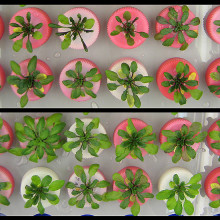
Salt-Tolerant GM Plants
Australian scientists have developed a technique to make plants salt-tolerant.
Writing in the leading plant sciences journal The Plant Cell, Adelaide University researcher Professor Mark Tester and his team explain how they have used genetic techniques to increase the activity, in the plant's root tissue, of a gene called HKT1;1.
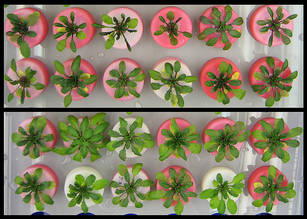 "This gene transports sodium out of cells," explains Tester. "So what we've done is to discover a way to increase its expression selectively in the cells that surround the xylem vessels. These are the conduits, like tiny pipes, that carry water and salts from the roots up into the plant shoots. What we have found is that when HKT1;1 activity is increased the plants pump more sodium salts out of the xylem and into specialised stores within the root tissue."
"This gene transports sodium out of cells," explains Tester. "So what we've done is to discover a way to increase its expression selectively in the cells that surround the xylem vessels. These are the conduits, like tiny pipes, that carry water and salts from the roots up into the plant shoots. What we have found is that when HKT1;1 activity is increased the plants pump more sodium salts out of the xylem and into specialised stores within the root tissue."
The result is that much less sodium makes its way up the plant, preventing damage that would normally occur through high sodium causing shoots and leaves to age prematurely.
"This is why plants won't normally grow well on salt-contaminated land because they end up devoting most of their energy to replacing damaged tissues rather than growing. These modified plants, on the other hand, even when cultivated on the equivalent of highly salt-contaminated land, show no ill effects," Tester explains.
The team made the discovery using Arabidopsis, the scientist's plant equivalent of a fruit fly, but will it work in important food crops?
"We've been able to show this this same trick also works in rice, and we're currently testing cereal crops, like wheat, barley and maize at the moment," says Tester. These latter plant groups have turned out to be slightly trickier to work with because the promoter system - the DNA sequence that that team have used to turn on the sodium-pumping gene in Arabidopsis and in rice - does not appear to work the same way in cereals; instead the team have had to identify an alternative way to boost HKT1;1 activity.
The discovery is a major step forward because currently about one third of the world's food is grown on irrigated land, one-fifth of which is now significantly affected by salinity problems. As food demands continue to increase, coupled with the effects of climate change like unreliable rainfall and coastal flooding, the problem is likely to become much worse. Crops that can tolerate conditions like these may be critical in an uncertain future. But are they safe?
"We have checked these plants carefully and there is no evidence that the changes we have made are altering the accumulations of other salts or chemicals within the plant with the exception of a small change to the level of potassium," says Tester. "So we're satisfied that these plants do not pose a threat."

World Population Day
Every single minute, a woman dies from pregnancy related causes somewhere in the world. That's one statement from the Population Institute in Washington made to highlight World Population Day, held by the United Nations Population fund on the 11th of July.
 Global population is growing at a phenomenal rate - It took all of human history until 1830 for world population to reach one billion. The second billion was achieved in 100 years, the third billion in 30 years, the fourth billion in 15 years, and the fifth billion in only 12 years. Population is predicted to exceed 9 billion by 2050.
Global population is growing at a phenomenal rate - It took all of human history until 1830 for world population to reach one billion. The second billion was achieved in 100 years, the third billion in 30 years, the fourth billion in 15 years, and the fifth billion in only 12 years. Population is predicted to exceed 9 billion by 2050.
We're made very aware of the threats of a changing climate, how rising sea levels could force millions out of their homes, threaten food security and increase conflict, but rising population can only make all of these effects worse. Larger populations need more land for crops, reducing forest cover, decreasing biodiversity and ecosystem services and actually making climate change worse.
Overpopulation is also at the root of more immediate human problems - poverty, HIV/AIDS, childhood illness, access to drinking water and the effectiveness of vaccination programmes are all made worse by being overpopulated.
World Population day hopes to raise awareness of the issues of overpopulation, especially to governments who are considering ways to save money in the current financial climate.
There's no quick fix for overpopulation, and it's certainly not something we can solve in a single day, but an awareness of the problems and opportunities can help us, and our governments, make the right decision.
Investments in women's education, family planning, public health and other social services can make a difference, and should not be allowed to suffer because of the global financial crisis. Already, developing nations are feeling the consequences of the financial crisis in the west -the credit crunch has affected funding for HIV/AIDS programmes in Africa; 90% of family planning in Uganda relies on overseas funding and half of the funding for healthcare in Africa comes from funding sources in America. A financial crisis in the west risks becoming a humanitarian crisis in the developing world.

Branched Blood Vessels Slow Statins
The shape of blood vessels may affect how effective Statins are against preventing heart disease, according to new research published in the Journal of Biological Chemistry this week.
 Statins lower levels of Low-Density Lipoprotein, or LDL, Cholesterol found in the plasma of our blood, and so help to prevent the fatty build-ups that lead to blocked arteries and heart disease. They're very widely prescribed to people at high risk of heart attack, and estimated to save nearly ten thousand lives per year. This research, from a team at Imperial College London, is the first to show that biomechanical forces effect how well Statins will perform.
Statins lower levels of Low-Density Lipoprotein, or LDL, Cholesterol found in the plasma of our blood, and so help to prevent the fatty build-ups that lead to blocked arteries and heart disease. They're very widely prescribed to people at high risk of heart attack, and estimated to save nearly ten thousand lives per year. This research, from a team at Imperial College London, is the first to show that biomechanical forces effect how well Statins will perform.
Statins are thought to help by releasing anti-oxidants through boosting levels of an enzyme called heme oxygenase-1, of HO-1, which is created by the endothelial cells that line our arteries. By measuring the levels of HO-1 in different parts of the circulatory system, Dr Justin Mason and colleagues were able to ascertain how useful Statins are under different conditions.
They found that the increase of HO-1 was significantly higher in cells exposed to fast, regular blood flow, when compared to areas where blood flow was sluggish. This means that at areas where blood vessels branch and flow is disrupted, Statins show fewer beneficial effects.
Unfortunately, arteries do not clog up in a uniform way, and are more likely to develop fatty deposits in the areas where blood moves most sluggishly - exactly where the Statins have least effect. Other research has shown that the cells lining our arteries can sense the 'shear stress' exerted by passing blood, and this alters their ability to keep the artery healthy. Dr Mason described this as "a double whammy".
They now intend to work with fluid engineers to discover how to get the best from Statins, and gain the full beneficial effect regardless of the rate and smoothness of blood flow. We already know that Statins are safe and effective, and this research could expose a way to save even more lives.

14:25 - The Rap Guide to Evolution
The Rap Guide to Evolution
with Baba Brinkman, babasword.com
Chris - Now this week was also Cambridge University's Darwin Festival. What actually happened was that we've had a full week of events which have been designed to celebrate the 200th anniversary of the birth of Charles Darwin who was actually a Cambridge University student. Also, it's 150 years since he published arguably one of the most famous books of all time, The Origin of Species which effectively rewrote our understanding of the world of biology around us. But one event that took place as part of the festival and really leapt out was a Canadian hip-hop artist - he's actually an erstwhile medieval historian - His name's Baba Brinkman, and he unveiled his answer to Darwin which is his Rap Guide to Evolution and he spoke to David Fisher all about it.
 David - The week here at Cambridge has seen mostly older scholarly types in panel discussions or alone at the lectern, analysing, speculating, debating, and theorizing over every nuance of Charlie Darwin's existence. So, for a summary of the week, here's rap artist Baba Brinkman who covers every angle of every session in his hip-hop show, The Rap Guide to Evolution.
David - The week here at Cambridge has seen mostly older scholarly types in panel discussions or alone at the lectern, analysing, speculating, debating, and theorizing over every nuance of Charlie Darwin's existence. So, for a summary of the week, here's rap artist Baba Brinkman who covers every angle of every session in his hip-hop show, The Rap Guide to Evolution.
Baba - So whatcha know about natural selection?Go ahead and ask a question and see where the answer gets you.
Try the impassive aggressive or try smashing heads in and see which tactic brings your plans to fruition.
And if you have an explanation in mind then you're wasting your time coz the best watchmaker is blind.
It takes a certain base kind of impatient mind to explain away nature with intelligent design.
But the truth shall set you free from those useless superstitious beliefs of the literal Adam and Eve and that Edenic myth 'coz their family tree is showing some genetic drift.
Take it from this bald headed non-celibate monk with the lyrical equivalent of an elephant's trunk.
It's time to elevate your mind's state and celebrate your kinship with the primates.
The weak and the strong, who got it going on. We lived in the dark for so long.
The weak and the strong, Darwin got it going on. Creationism is dead wrong. Tell them Dawkins...
David Fisher - This Canadian rapper is no scientist. His area is medieval literature. After applying rap to the Canterbury tales, he was approached by a microbial genomist who asked if he could do for Darwin what he did for Chaucer. Baba read his way through a pile of books on evolutionary biology and out spawned his Darwin show, covering every aspect of the great man's work. And according to Baba, there's a curious similarity between the creation, sorry, the growth, the evolution of an artistic work and any living thing.
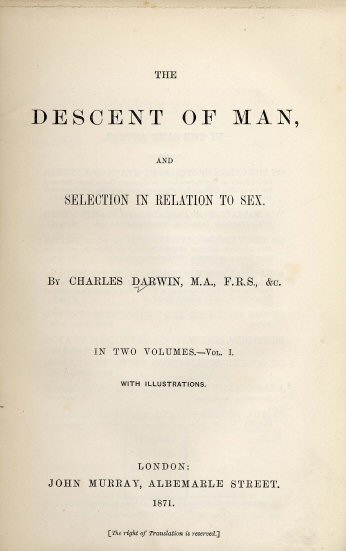 Baba Brinkman - When I first started writing the show back in January, early drafts of the script sounded a little bit like this:
Baba Brinkman - When I first started writing the show back in January, early drafts of the script sounded a little bit like this:
Yo!yo!The origin of species ain't no faeces.
Dawg, believe me.
Yeah!
And that was all I think of.
And then I thought, I thought. Well, maybe my show needs to get rewritten and sometimes, people ask me how does a show get written?
Like this, performance, feedback, revision.
And how do I generally develop my lyricism?
Kind of like this, performance, feedback, revision.
And how do human beings ever learn to do anything?
Like this, performance, feedback, revision.
And evolution is kind of just an algorithm, isn't it?
That goes like this, performance, feedback, revision.
So, really the genetic code of very living thing was written like this,
Performance, feedback, revision.
So, the genes are like a text with a thousand pages and revisions occur in the random changes that come from mutations and then when they...
Chris - That's rap artist Baba Brinkman from Canada who was able to be here in Cambridge touring with his rap, effectively Darwin set to a rap tune. He was talking to David Fisher who was an honorary member of The Naked Scientists for a week but you'll normally find him at ABC at Radio National in Sydney, Australia.
We've actually got a recording of that entire show and we're going to be publishing it for you as a special podcast on our website later this week. So, if you check out thenakedscientists.com/podcasts, then you should be able to listen to all of Baba Brinkman's show.
How could we make electric cars noisier?
Ben - That's a very nice idea and I can see how it would work but I can also see a couple of problems because if we start to rely on these, if you have the vision-impaired community relying on these, in order to avoid being hit by very quiet electric cars, then what happens when it goes wrong one day? And I really think that we need to find ways where we don't rely entirely on technology to get around this. I've wondered what they must do in Holland because I've been to Holland a few times and they have trams there that are virtually silent as well. With the amount of cyclists around, crossing the road in Amsterdam, really can be quite a hazard because there'll be cyclists coming from one way, a tram coming from the other and if you're not looking out carefully, they might well hit you. So, I think we'll probably find a way around it that doesn't involve this sort of technology but it's a really nice suggestion. Thanks very much.
Would the fungus-based anti-flea drug also kill mosquitoes?
Chris - Indeed, this was the nodulisporium fungus which is an environmental fungus but it produces nodulisporic acid which the paper we reported on last week is scientists making a version of that called nodulisporamide which targets an ion channel which is only present in insects. It's not present in people and it's therefore neurotoxic to insects but because we don't have their ion channel, it's harmless to us. I suppose it's possible that we could do the same thing for other flying insects. The problem is of course, you'd have to dose enormous numbers of people. If you're going to dose enormous numbers of people or something, you might as well give them an anti-malaria drug in the first place. So, I guess that that's one of the criticisms. Isn't it? That if you're going to do something like that, well, might as well treat the disease that's mostly the problem, but it's a good idea and it may be that that's one way to tackle this.Ben - That's very true. If we already had the facility to dose that many people with any medication then, yes, we'd be using anti-malarials, wouldn't we?
Could you make a phone call with a mobile phone in a car, underwater at the bottom of a river?
Chris - What he's getting at, is that radio waves do not propagate very well through water. Part of the reason is a radio wave is an electromagnetic wave and as water contains lots of dissolved salts and ions, you can't get the signal to go very far. That's why submarines, when they're underwater, they can't communicate very easily. They have to surface or they can only communicate with limited range and they tend to use sonar because sound travels very, very easily underwater but radio waves are soaked up by the fact that they are a moving electromagnetic wave and this makes the ions in the water go backwards and forwards and so, you lose all your energy in your radio wave very quickly underwater.Ben - Right So, I wonder, should you happen to be trapped in a car underwater at the bottom of a river, how on earth do you get somebody to come and help you?Chris - I think you have to get out. I don't think that your mobile phone signal is going to spread very far, unfortunately.
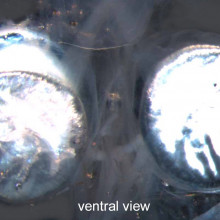
30:55 - Deep Sea Sight
Deep Sea Sight
with Professor Ron Douglas, City University
Chris - It's The Naked Scientists with Chris Smith and with Ben Valsler. We're talking about the science of eyes and the visual system this week and in a second, we'll be finding out what actually is an optical illusion, how does it work, and do bees fall for the same trick. That's on the way but first, we welcome Professor Ron Douglas. He's from City University in London. Hello, Ron.
Ron - Hello.
Chris - Now, you've made an amazing discovery about one way in which some fish see things which will come to in just a second. But first of all, tell us first very, very simply, how do eyes work?
Ron - Okay. Well as we've heard already, it's important to understand that vision involves both the eye and the brain. And really, in some ways, the eye is like a camera in that it produces an optical image of the world and it then converts that optical image into something that the brain can understand which is a series of electrical signals. So the cornea on the lens of the front of the eye make the image and then the retina as we just heard converts that image into electrical signals which the brain then interpret.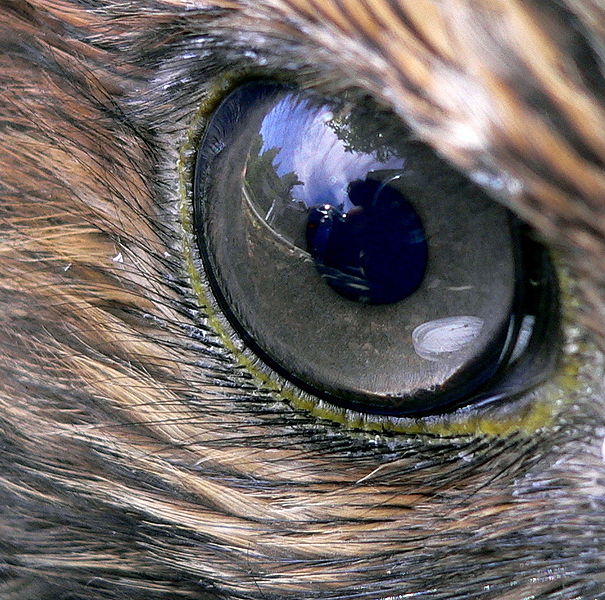
Chris - Now one of the things that you're very interested in is animals that live beneath the sea. The sea is blue for a reason because it soaks up all the red light. That's why blood doesn't look red underwater so the people who made Jaws were kind of misleading us a little bit weren't they because bloods looks a sort of black colour because there's no red light to illuminate it. So what do animals deep underwater where the spectrum of light is very different, what do they do to accommodate or adapt to that.
Ron - Well because of that and in the deep sea, there's only two sources of light. There's light from the sun but that's all gone by about a thousand meters and the ocean is up to 10,000 meters deep and most of the animals that live there have large and fully functional eyes so they clearly must be looking at something. And they are looking at light produced by other animals, that is their looking at bioluminescence. Now this bioluminescence like the sunlight tends to be blue because blue light is just transmitted best by seawater so deep sea animals generally have eyes which only see blue and they're not at all sensitive to red because as you said, all the red light is gone.
Chris - And things like a giant squid have enormous plate-sized eyes presumably because the bigger you make your eyes like the telescopes we use, the bigger the telescope, the more light it can gather. Therefore, the more you can see.
Ron - Absolutely! You want a big aperture, so you want a big pupil, so that means you need a big eye. So, you just have a big eye to catch as much light as you can.
 |
| Figure 1. Surface Morphology of Dolichopteryx longipes © Julian C. Partridge et al.; Current Biology; 27 January 2009. |
Chris - So if you look at the retina in these undersea creatures, are they largely, then because most of these animals that they're looking at are emitting lights that are bluish, are they mainly picking out blue light? They haven't got the ability to detect light at the other end of the visual spectrum, like reds and things.
Ron - Well I would say 99.9% no. They can't see reds, but we have found one group of fish, the so-called dragon fish which produce red light. So, they're producing red light that really nobody can see except they themselves, we've shown that they are very sensitive to red light. So, they basically have a secret wavelength. They have a red searchlight stuck on the top of their head and they can use that for instance to illuminate potential prey and the prey just don't know they're being looked at. It's kind of like a sniper scope on the end of a rifle.
Chris - It was like an infrared camera I suppose, isn't it? We can't see infrared but the person operating the infrared camera can see us because they're looking in a wavelength regime that we're not sensitive to.
Ron - It's exactly like that. And of course, they can also use it to talk to each other because down there, all the animals have very big teeth, basically because the density of animals is quite low so you rarely meet your lunch so when you do, you want to make very sure that you can eat it. So, it's a rough tough place down in the deep sea, but if you have a light that you can flash on and flash off and talk to your friends, you know, for sex or whatever you have on your mind, then nobody else can see that you're there.
Chris - Do they use that to communicate so they can hunt together or is this purely just to attract a mate or to ward people off, "this is my territory, stay away."
Ron - We don't know because it's very difficult to make observations on live animals that deep. My guess is it's mainly for communication. There's no evidence that they're territorial and there's certainly no evidence that they hunt as a pack.
Chris - What about these fish that you've recently described? Just this one species that don't have traditional eyes. They actually use mirrors, a bit like some of the funky telescopes that we're making to look at the heavens these days, use mirrors rather than lenses. How do these fish do that?
Ron - Well, they've got very interesting eyes because the eyes are made up of two parts. Now, the two sources of light in the oceans we've said are the sunlight which of course comes from above. So, a lot of deep sea animals have tubular eyes which point out towards the sky to make the most of the residual sunlight but of course, the bioluminescence which the animals make happens all around you. So if you've got these tubular eyes looking upwards, then you're not going to see all the bioluminescence it's happening to the side and it's happening underneath. So, we found these fish that have an eye that are made of two parts. It has a tubular eye looking upwards but it also has a second eye or part of the same eye which actually looks downwards and the interesting thing was while the tubular eye that looks upwards focuses light using a lens, just like anybody else, the eye that looks downwards doesn't have a lens in it. Instead, it has a mirror and it focuses light using a mirror.
Chris - When you say mirror, what tissue is doing that? How have they evolved to be able to reflect light rather just absorb it or focus it?
Ron - I think most of the scene, when we look at nocturnal animals, something like a cat or maybe a deer, when you catch it in the headlights of your car, they're eyes suddenly light up and that's because animals that live in low light levels have a reflective layer behind their light sensitive cells called the tapetum, so that the light that goes through the retina and isn't absorbed by it, gets bounced back, so the retina has a second chance of absorbing it. So, most of animals including deep sea fish have these reflective tapeta and this mirror is really just a modification of this reflective tapetum.
Chris - Is it evolutionarily, the same origin then as the dog and the cat and the deer and the cow and the horse or is it evolved independently?
Ron - No. It's absolutely the same. It's made of the same chemicals. It's made up of plates of a crystal called guanine. It's identical in every way.
Chris - Fantastic! Thank you, Ron. That's Ron Douglas, he's from City University.
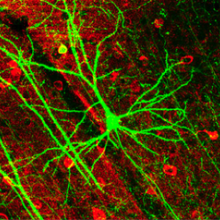
37:15 - Paying Attention
Paying Attention
with Professor Alex Thiele, Newcastle University
Ben - Now, that's how the eye itself works even in some very unusual circumstances but an eye alone isn't much use without a brain to interpret what the pictures mean. It's not fully understood just yet how the brain interprets information from the eyes. There have been some very great advances recently. A Japanese team could predict what letter was being read just by looking at brain activity alone for example. But we do still have a long way to go. Now one problem is the issue of attention. How does the brain know what's important in any given view? Professor Alex Thiele is from Newcastle University where he's trying to work this out.
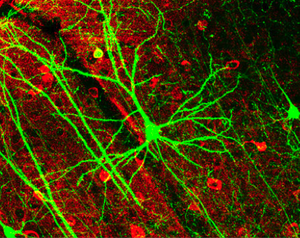 Alex - I'm interested in how attention works and particularly in a mechanistic analysis of attention. So we kind of know what attention does to various aspects of our everyday perception but we don't really understand how it is implemented in the brain. So I'm looking at the brain chemicals that mediate various aspects of attention and I'm also looking at how neurons are affected by these brain chemicals and how neurons communicate and how neurons interact during attention. And one current view is that synchronous or oscillatory activity between groups of neurons is a very important aspect of attentional processing and I'm looking at those aspects, how different areas synchronize their activity and what these neuron modulators or neurotransmitters these brain chemicals, what role they play in this synchronicity.
Alex - I'm interested in how attention works and particularly in a mechanistic analysis of attention. So we kind of know what attention does to various aspects of our everyday perception but we don't really understand how it is implemented in the brain. So I'm looking at the brain chemicals that mediate various aspects of attention and I'm also looking at how neurons are affected by these brain chemicals and how neurons communicate and how neurons interact during attention. And one current view is that synchronous or oscillatory activity between groups of neurons is a very important aspect of attentional processing and I'm looking at those aspects, how different areas synchronize their activity and what these neuron modulators or neurotransmitters these brain chemicals, what role they play in this synchronicity.
Ben - Attention is a word that we use in common language a lot. We pay attention to a television program we're interested in or we pay attention to the weather broadcast for example to know what's coming up. Does it mean the same thing for you as it would do in common parlance?
Alex - In a way it does, and at the same time it doesn't. I think until a few years ago, attention was used in a fairly restrictive manner but most people now start to argue that attention really is just the process that allows us to use task relevant information appropriately. So if we are involved in a certain task, then we have to pay attention to the aspects that allow us to do the task. In tennis its one specific set of aspects looking at the ball making sure our movements are right. If we watch the weather forecast, it's a different task. So attention really allows task relevant information to be processed adequately, and non-task relevant information to be excluded from interference.
Ben - So, how do we know what's going on in the brain while we're diverting our attention to one particular thing?
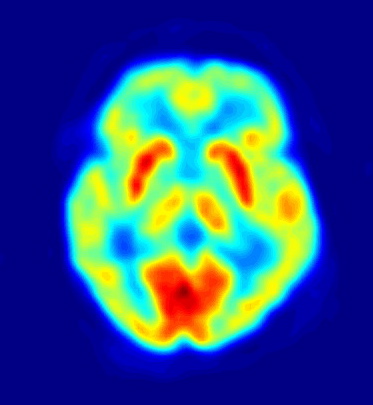 Alex - We know that neurons that process this particular aspect increase their activity so to speak, they shout louder. We also know that in, certainly in certain areas, neurons are synchronous and synchronous activity is kind of like clapping, a clapping audience that is synchronous where everyone claps at the same time makes the whole theater be much more noisy, much louder and that's what synchronicity in the brain also does in a way so we know the neuron shout louder. We know they act all together that then make sure that basically, they are above the noise and that aspects of the visual world reach consciousness.
Alex - We know that neurons that process this particular aspect increase their activity so to speak, they shout louder. We also know that in, certainly in certain areas, neurons are synchronous and synchronous activity is kind of like clapping, a clapping audience that is synchronous where everyone claps at the same time makes the whole theater be much more noisy, much louder and that's what synchronicity in the brain also does in a way so we know the neuron shout louder. We know they act all together that then make sure that basically, they are above the noise and that aspects of the visual world reach consciousness.
Ben - The brain is a phenomenally complicated and wonderful thing but it does have a tendency to go wrong. Are there processes where this attention can break down?
Alex - We are all distractible. There are diseases where attention doesn't work properly anymore. I mean Alzheimer's disease is one example, late stages of Parkinson's, certain stroke types show that attention doesn't work properly. In everyday life it would be more distractibility, that we can't focus properly, but how this actually happens in everyday life. I don't think people understand properly yet.
Ben - And one of the things you're looking at is brain chemistry. How do the different chemicals in the brain translate to paying attention?
Alex - Well we know very little about that. We know that certain chemicals which are called modulators like acetylcholine or dopamine or an adrenaline play some role in attention but exactly what role they play is still very little researched. I mean we recently were able to demonstrate for one particular part of the brain, the primary visual cortex, that acetylcholine mediates its effect through a specific receptor type but that is just in this one particular area. All the other areas are still, its unknown how acetylcholine works there. It is also at least to a large extent unknown how for example dopamine contributes to attention in a very detailed and mechanistic manner. And then there are the more traditional neurotransmitters like glutamate which acts through certain receptors again where specific receptor type may or may not contribute to attention. So we're just about to begin to understand how these different brain chemicals contribute to various aspects of attention and also to what aspects of attention because as I've said at the outset, attention is a complex phenomenon. It allows task relevant information to be processed and different neurotransmitters may allow different types of task relevant information to be processed accurately so it's, and well in a way fortunately, but at the same time unfortunately, a rather complicated interplay of all these brain chemicals.
Ben - So there's so much still to learn. This is really exciting stuff. He was a wonderful chap to talk to and really it is an interesting question of what does attention mean to me and what does it mean to him and what it means to other people. So there you go, that is Professor Alex Thiele from Newcastle University, explaining how the brain relies on coordinated nerve activity and a whole cocktail of chemicals in order to pay best attention to the world, depending on exactly what you're doing at the time.
Why do night vision goggles traditionally produce a green image?
Chris - I think this is probably a legacy of our pre-LCD era. We take for granted having these flat screen, very light screens now, but in the old days, not so long ago actually, we relied on cathode ray tubes, these big old giant television-like things that we had in our living rooms and that technology could be condensed down to something fairly compact but still quite bulky which was the way of making an image on a screen. Green is a good choice for two reasons. One is that the phosphors, the things that glow and make the colour are relatively easy to make it green. And because the eye is more sensitive to green light than virtually any other wavelength, it means that you can make your display dimmer than any other wavelength and your eye will be sensitive to it. And it means therefore, you can run your thing with less power than you would otherwise need to make another colour visible so green's a good choice. And I think also when you're looking with night vision goggles, you're actually seeing monochrome anyway, it's a black and white picture anyway. There's no colour information that can be conveyed so it doesn't matter that it's only just in one colour.Ron - And the dragon fish that live in the deep sea that are as mentioned just now that see red light. They actually see the red light using chlorophyll and the laboratory in the states have now started putting chlorophyll into the eyes of mammals, things like rats and mice and have been able to make them super sensitive to red and there's even been the suggestion that you could do this with humans so that you can make them almost infrared sensitive and you wouldn't need goggles at all.Chris - So this would be a sort of military application. You could give your pilots or your armed personnel super red vision so that they could see the enemy on the battlefield glowing because they're putting out heat.Ron - Absolutely, theoretically as you would say.Chris - That's wonderful. Thank you Ron.
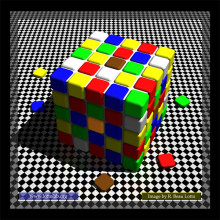
45:13 - Learning from Bee Brains
Learning from Bee Brains
with Beau Lotto, University College London
Ben - The only visual information we have about the outside world, thinking about it objectively is patterns of light that fall on our eyes. We've just heard how the brain can interpret that light differently depending on what you're doing at the time. But actually, all this means that we don't really see what's really there, the context itself is important. To find out why, Beau Lotto from the University College London is looking at optical illusions, and finding out how bees see the world. Meera Senthilingam went along to have her eyes fooled...
Beau - So what we're looking at is a very well-known, very simple illusion called simultaneous brightness contrast and so we see two small squares and each of those squares is on two different surrounds.
Meera - Yes. Looking at this, there are two grey squares. One's on a darker grey background and one's on a white background and to me now, these two smaller grey squares look like different shades of grey.
Beau - That's right. But if you put up a photometer, if you put up a light measurer to them, you would find out that those smaller squares are physically the same. Their emitting the same amount of light to your eye and yet they look differently bright. Now most textbooks would say, the reason for this is simply that one is on a light surround and one is on dark surround but that answer can't be right because I can also create an illusion where something on a dark surround looks darker than something on a light surround. The illusion goes exactly the opposite direction. So it can't simply be about, it's the lightness and the darkness of the surround that matters. The argument here is what those relationships meant for your behaviour in the past?
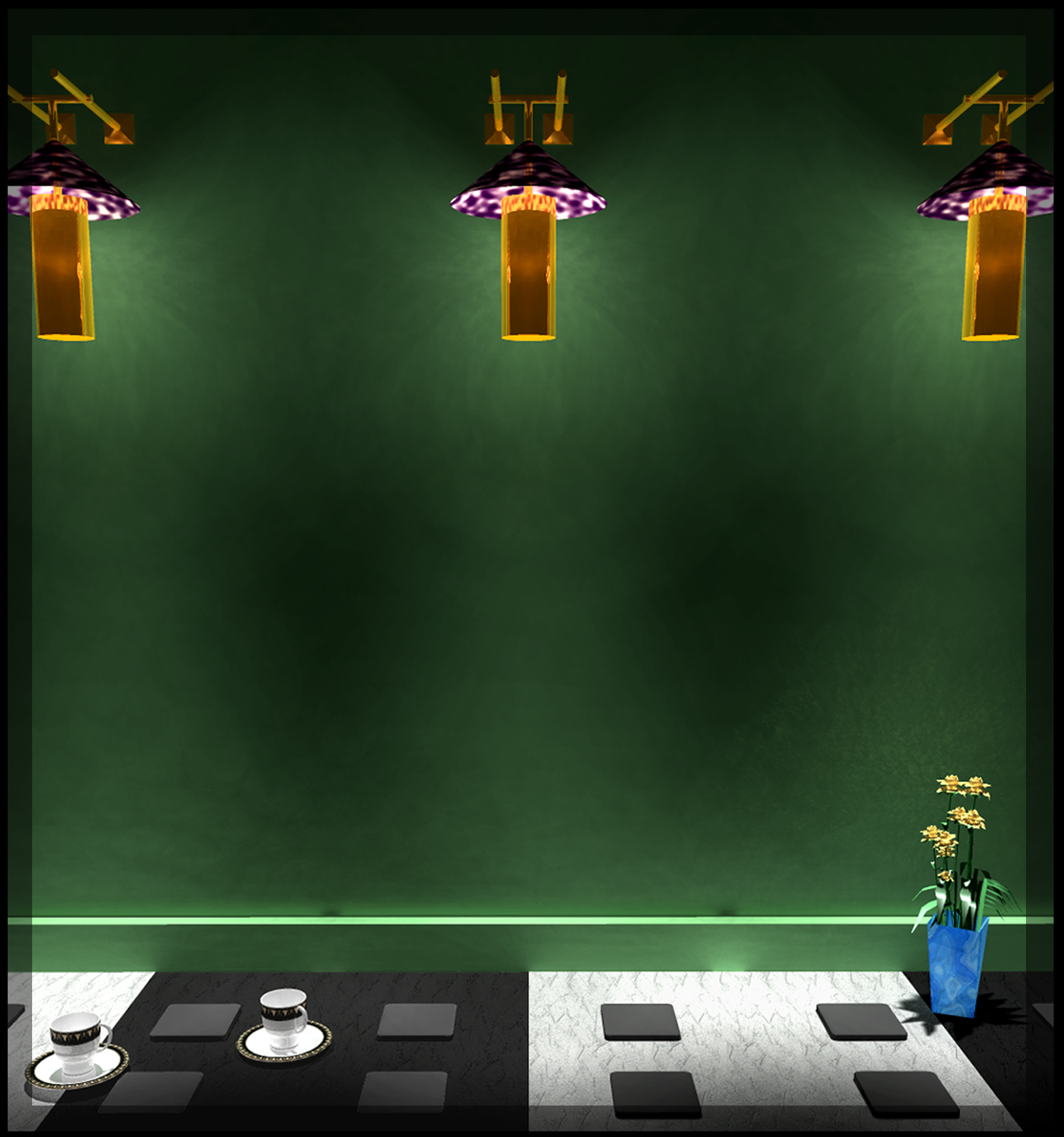 |  |
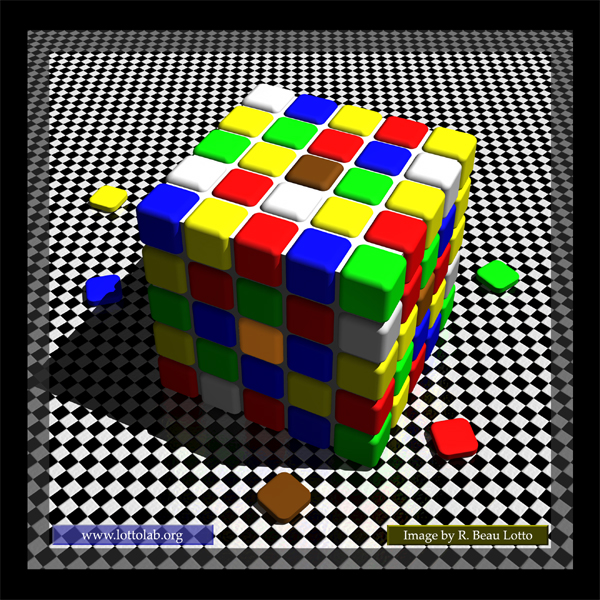 | 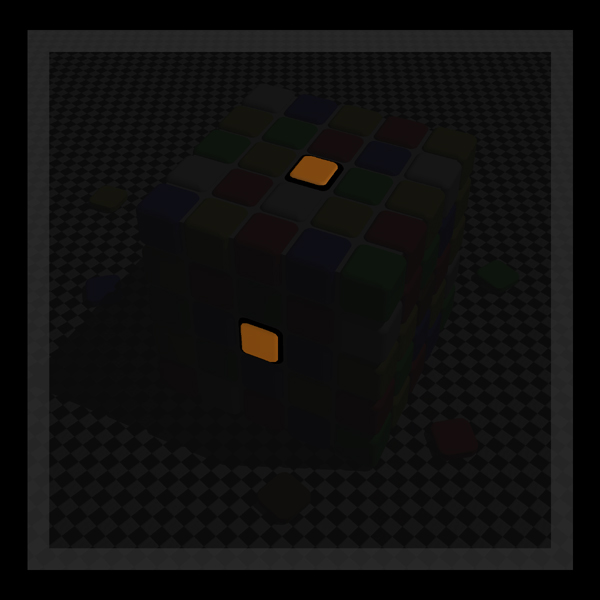 |
Meera - So having used all these images and knowing what you know so far, do you know much about the actual physiology and the mechanisms going on in our brains that cause us to see these illusions in this way.
Beau - Well to understand how we see illusions is to understand how we see generally. And what this work suggests is that the only way we can understand perception is to quantify our history of experience or with humans, this is very difficult because our history is for the most part lost to us. But fortunately, to understand something like seeing colour and dealing with the ambiguity of light stimuli, we don't need to work, focus on humans when in fact, we don't even need to focus on mammals. We can look at insects and in particular, we can look at bumblebees. So the beautiful thing about bumblebees is that they see colour and we see colour. Their brain is able to resolve the ambiguity of light stimuli and the wonderful thing about bumblebees as opposed to honeybees is that we can completely control their visual experience which means that we can raise them in an environment where we know everything about the colours that they have seen. And we can look to see how that experience shapes itself in the architecture of their brain and also the resulting behaviours.
Meera - So how do you know ago about testing these bees because I just now have an image of you showing lots of illusions to bees.
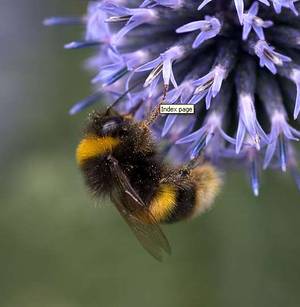 Beau - Well in a way we do actually. So we do that in a space we call the bee matrix. It's a plexiglass cube that's one meter on all sides and at one end, you have 64 flowers that are lit up from behind and with these flowers, we can control the colour by putting filters behind them and we can train the bees to go to certain colours and not others. So if they land on the right colour, they get a sugar reward. If they land at the wrong colour, they get saltwater. So what we can do is we can train them to go to, for instance, find the blue flower, except the blue flower is now under different colours of light. So the light coming from the blue flower varies. So what they have to do is they have to use their relationships between the flowers and the surround in order to figure out which is the cracked one and what we found is that they do that. They actually encode the colour relationships so they can learn to go to the bluest flower in the array or the yellowest flower in the array. Now sometimes, a grey flower is the bluest flower if everything else is yellow so it's actually a pretty complex thing that they're doing and then what we can do is we can look to see how those relationships are encoded in the architecture of their brain. So the brain doesn't do absolutes. It can't do absolutes. There's no point in seeing absolutes. What it does is it encodes relationships and it's actively encoding the relationships that matter.
Beau - Well in a way we do actually. So we do that in a space we call the bee matrix. It's a plexiglass cube that's one meter on all sides and at one end, you have 64 flowers that are lit up from behind and with these flowers, we can control the colour by putting filters behind them and we can train the bees to go to certain colours and not others. So if they land on the right colour, they get a sugar reward. If they land at the wrong colour, they get saltwater. So what we can do is we can train them to go to, for instance, find the blue flower, except the blue flower is now under different colours of light. So the light coming from the blue flower varies. So what they have to do is they have to use their relationships between the flowers and the surround in order to figure out which is the cracked one and what we found is that they do that. They actually encode the colour relationships so they can learn to go to the bluest flower in the array or the yellowest flower in the array. Now sometimes, a grey flower is the bluest flower if everything else is yellow so it's actually a pretty complex thing that they're doing and then what we can do is we can look to see how those relationships are encoded in the architecture of their brain. So the brain doesn't do absolutes. It can't do absolutes. There's no point in seeing absolutes. What it does is it encodes relationships and it's actively encoding the relationships that matter.
Meera - And this is all not just through the training of them from their birth but it actually just goes through the past evolution of the bees and of us humans.
Beau - That's true so we come into the world with the ability to encode relationships. When we talk about experience, we don't distinguish between evolutionary history or development or memory. Basically, they're all different ways of doing the same thing which is to shape the brain according to its trial and history of experience.
Meera - So you now know this about the bees' behaviour but what are you working on now and next in order to understand just what's going on inside the brain?
Beau - So what we want to do now is trying to discover how those relationships are actually encoded in the structure of their brain and to do that, we can take little electrodes which are fine, fine wires and stick them into the brain of the bee and we can listen to their brain cells while they see the history of their own visual experience. The reason why we do it in humans and bumblebees is that these are very, very different types of brains taking the same kind of information coming up with the same solution. And if we can understand how both types of brains do it, then we can understand the principle that is relevant to both.
Is green for me the same as green for you?
We put this question to Professor Ron Douglas:Ron - That's almost a philosophical question. The first thing to say is that what's happening in the eye in all of us is the same. We have the same chemicals. We have the same responses to the light but its what our brain makes with this information that's different. So for instance, if you take, you know, if you were I, you'll probably be appalled to hear we're fairly similar. If you have all chips of all different colours and you put them into different piles, we would make a pile for green, a pile for blue, a pile for yellow, a pile for red. But if you ask people for instance some African tribes who've had very little contact with the Western world, they will put them into different piles that they will put yellows and reds together and swear blind that they're the same colour and they will put blues into different piles and closer to home. Even in Welsh, there is a word called glas which encompasses what you and I would call blue but it also encompasses some things that we call green.Chris - Wow! But if you look in the retina, the thing that's doing the seeing and converting light waves into brain waves, is there a dramatic difference between the way the African tribes who do what you've just described are doing that and us.Ron - No! There's absolutely no difference at all in what the eye is doing but it's a difference in the brain, it's where culture comes in to play and interacts with the visual stimulus.
What causes the Photic Sneeze Response?
Chris - No. People did think but it happens too quickly. The photic sneeze reflex to recap is when you go out on a sunny day, bright light comes to you and you suddenly feel this irresistible urge to sneeze often multiple times. About one person in five is affected, tends to run in families, and it seems to be a neurological phenomenon. It's not a tear tickling your nose phenomenon because you tend to sneeze quicker than your eyes water so people have sort of written off that theory unfortunately. So we think it's more the same thing that makes your pupil get smaller and you blink in response to bright light, probably the same bit of the brain that's doing that is also crossing over into the sneezing center a little bit and triggering both reflexes.Ben - So it's wiring rather than plumbing?Chris - Absolutely!
![Eggs, illustration by Adolphe Millot from Nouveau Larousse Illustré [1897-1904] Eggs, illustration by Adolphe Millot from Nouveau Larousse Illustré [1897-1904]](https://www.thenakedscientists.com/sites/default/files/styles/medium/public/media/452px-Oeufs002b.jpg?itok=nWuUOXee)
53:38 - Ventilating an egg?
Ventilating an egg?
Diana - So how do chicks breathe before they hatch?Kirsty - My name is Kirsty Peck and I work as a wildlife advisor for the RSPB. Well an egg is a very complicated structure. And as you can imagine, it's got all the different life support systems for the chick in that tiny little package. And the embryo itself lies right next to that huge yolk in the centre of the egg. And as it develops, there are all kinds of membranes that will eventually form the different organs in the chick. One of these membranes, they call it the chorion is one that it kind of envelopes part of the yolk sac and also it runs along the outside of the shell in part of the egg. The chorion has got the very thin walled network of blood vessels all along it and in the same way, the blood vessel that you will find in that along would be picking up oxygen from the air inside the lung. The chorion will pick up oxygen through the shell because you've got to remember, the shell of an egg is porous so oxygen can come in and at the same time any carbon dioxide from the blood can be excreted out through the shell.Diana - The chorion acts as a lung tissue within the egg but what happens when the chick wants to escape?Kirsty - What happens of hatching is that as you probably know, an oval shaped egg in the wide end of it, there's a little air pocket and at hatching, as the blood vessels in these membranes will wither away and drop off, then the chick will be relying on the air and not the air pocket as it's starting to break through the shell which will give it kind of something like a scuba diver's aqualung or something to give it a limited air supply while still it's breaking out of the egg.
- Previous How the Turtle Got its Shell
- Next Trees, Tyres and Teleportation
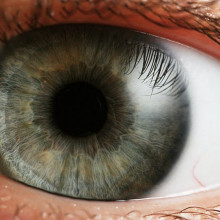




Comments
Add a comment